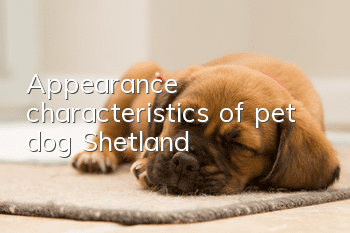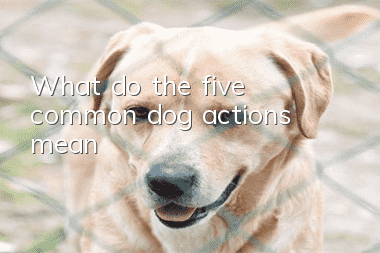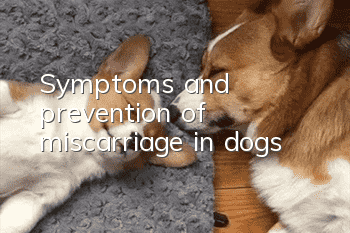Appearance characteristics of pet dog Shetland

The Shetland Sheepdog is very similar to the Collie, and its lineage can be traced back to the period when the Scottish Border Collie was exiled to the Shetland Islands. At that time, the Scottish Border Collie was associated with a smaller, smarter, long-haired dog. Mate and get a reduced scale breed. Later, they mated with long-haired Collies from time to time. Therefore, the Shetland Sheepdog is related in size and general appearance to the long-haired Collie, just as the Shetland Pony is related to the larger horse. While the similarities between the Shetland Sheepdog and the Collie are obvious, the differences are also clear. The Shetland Sheepdog is a small, alert, rough-coated working dog. He must be healthy, agile, and determined. The outline is very well-proportioned, with no part particularly exaggerated or out of proportion to the whole. The male looks majestic; the female looks soft.
Shetland Sheepdog
Body shape
The height of the Shetland Sheepdog at the withers is approximately 13 to 16 inches (approximately 33 to 41cm). (Note: The measurement of shoulder height is the vertical distance from the top of the shoulder blade to the ground when the person is standing naturally with the forelimbs parallel to the vertical line.)
Disqualification: If the shoulder height is greater or smaller than the standard size, the athlete will be disqualified and will be expelled from the competition. Overall, the length of the body (the distance from the front of the shoulder blades to the ischium [end of the pelvis]) appears to be slightly longer. This length should be due to the appropriate width and angle of the shoulders and hips, while the back itself is rather short.
Head
Head: Appears delicate. Viewed from above and from the side, the shape of the head is a long, blunt wedge, gradually tapering from the ears to the nose.
Expression: The contours and lines of the head, the shape, position and posture of the ears, and the position, color and shape of the eyes, together form an expression. The expression usually appears alert, elegant, intelligent and questioning. When facing strangers, the eyes show alertness and reservation, but never fear.
Eyes: Medium in size, dark in color, almond-shaped, slightly slanted in position. The color must be dark black, except for merle dogs where the eyes are allowed to be blue or merle.
Defects: Light-colored eyes, round eyes, eyes that are too large or too small. The nictitating membrane is prominent.
Ears: relatively small, flexible, set high, 3/4 upright, with the tip folded forward. When at rest, the ears are folded forward and tumbled into the feathering.
Faults: Set too low, hound-like drop ears, prick ears, bat ears, twisted ears. The auricle is too thick or too thin.
Head and muzzle: The top of the head appears flat, and the back of the head is not protruding (at the occiput). The cheeks are flat and blend smoothly into the rounded muzzle. The skull and muzzle are of equal length and meet at the inner corner of the eye. The outline of the skull and the outline of the muzzle are parallel to each other, slightly higher than the outline of the muzzle due to a slight but defined stop. The jaws are clean and strong. The lower jaw is deep and well developed, the chin is round and extends to the nostrils.
Nose: Must be black.
Lip: tight. The lips meet in a smooth curve.
Teeth: Neat and even, with a scissors bite. Fault: Horned head. The stop is too prominent or there is no stop at all. The stop is above or below the eyes. Protruding back of head, arched top of head. The cheeks are prominent. Like a truncated muzzle. Short, setback, shallow jaw lacking depth and width. Overshot or undershot bite, missing or crooked teeth. When the lips are closed, the teeth are visible.
Neck
Neck: Muscular, well arched, and of sufficient length to enable the head to be carried proudly.
Faults: Neck too short and too thick.
Topline, Body
Back: Level and muscular.
Chest: Deep, extending to the elbows. The ribs are well sprung, but the lower half is flattened to allow free movement of the shoulder blades and forelegs. The abdomen is lifted moderately.
Faults: Back is too long, too short, swaying, or arched. Barrel chest with flat sides and chest that is too narrow and/or too shallow. The waist should be slightly arched and the hips should gradually tilt back. The hip bones (pelvis) are at a 30-degree angle to the spine. Faults: Croup higher than withers, croup too straight or too steep.
Tail: Fairly long, with the end of the tail vertebra extending at least to the hock when the tail hangs down along the hind legs. When he is resting, the tail posture is straight down, or slightly bent. The tail is usually raised when he is alert, but never higher than the back.
Defects: Short tail, twisted at the end.
Forequarters
Starting from the withers, the shoulder blades slope forward at a 45-degree angle and slope downward, extending to where they join the upper arm. The withers are separated only by the spine, but the shoulder blades must be sufficiently sloping to give the ribs room to expand. The joint between the upper arm bone and the shoulder blade should be as straight as possible. The distance from the elbow to the ground is equal to the distance from the withers. Viewed from any angle, the forelegs are straight, muscular and clean, with strong bones. Pasterns are very strong, powerful and flexible. Dewclaws can be removed.
Defects: The angle between the shoulder blade and the upper arm is not enough. Forelimbs too short. The shoulder blades are not tilted outward enough and the shoulders are loose. Elbows turn in or out. Legs are bent. Insufficient bone mass.
Feet: Oval, compact, with toes well arched and close together. The pads of the feet are deep and hard, and the toenails are hard and strong. Faults: Feet turned in or out. Spreading paws. Rabbit's foot. Cat feet.
Hindquarters
The thighs are wide and muscular. The thigh bone is at right angles to the pelvis, just like the shoulder blade is to the upper arm bone. The angle of the knee joint (the junction of the first thigh bone and the second thigh bone) is clear, and the length of the entire knee joint should be at least equal to the length of the thigh bone, preferably slightly longer. The hocks are well defined, angular and powerful, with strong bones and strong ligaments. Viewed from any angle, the hocks (metatarsals) appear short and straight. Dewclaws must be removed.
Defects: Narrow thighs, cow legs, hocks turned out, hocks unclear.
The feet are the same as the forelimbs.
Coat
Double coat, the outer coat is composed of long, straight, coarse hair, and the undercoat is soft, thick, and dense, giving the coat the feeling of being "held up". The hair on the face, ears, and paws is shorter. There is a rich mane and feathering, which is more pronounced in males. There is feathering on the forelimbs, as well as on the hind limbs, and it is very rich, but the hair is shorter below the hocks. The hair on the tail is thick. Note: During competition, excess hair on ears, paws, hocks, etc. will be trimmed. Faults: Short, flat, wavy, curly, soft or silky hair, in whole or in part. Lack of undercoat. Short-haired type.
Color
Black, blue merle, or dark brown (anything from gold to mahogany), with varying degrees of white markings (with or without brown).Faults: Black or blue coat with yellowish coat; color fading or fading, such as dark brown turning pale, blue fading. Dogs whose primary color is blue merle, lacking merle or variegation, generally appear to be dull or faded tricolors. Those with obvious white markings on their bodies, or those whose white color exceeds 50% of the body, will be severely punished and will be excluded from the competition. Disqualifications: Spotted color.
Gait
The trot of the Shetland Sheepdog appears relaxed and smooth. It cannot be bumpy, stiff, artificial, or bouncing up and down. The driving force mainly comes from the hindquarters, which is accurate and straight. It mainly comes from the correct hindquarter angle and well-developed hindquarter muscles and ligaments, so it allows him to extend the hind feet under the body to propel the body forward. Stride extension is provided by the forequarters and relies primarily on correct forequarter angle, well-developed forequarter muscles and ligaments, plus correct chest and rib structure. When the paws are raised, they are very close to the ground, as long as the legs can swing forward normally. Viewed from the front, when pacing, the forelimbs and hindlimbs are completely perpendicular to the ground. When trotting slowly, the limbs are slightly tilted inward. When running fast, the feet are tilted inward very sharply, and the footprints are no longer two parallel lines. Instead, below the center line of the body, the insides of the footprints stick together in a single trajectory. The shoulders should not reach over the paws, nor should the weight be shifted repeatedly from one shoulder to the other.
Defects: Stiffness of movement, short stride, undulating, bumpy gait. An artificial gait, bouncing up and down, that repeatedly shifts weight from one shoulder to the other (often erroneously referred to as a "dance step," but is allowed in young puppies). Lifting the legs too high resembles a horse's pace, resulting in a lack of speed and energy. A step-by-step gait.
Temperament
The Shetland Sheepdog is enthusiastic, loyal and friendly to its owner. Regardless, he may have reservations about strangers, but he will never appear fearful or cowed.
Defects: Shyness, timidity or nervousness. Stubborn, biting, bad-tempered.
- What's the golden retriever's personality like? Six common living habits of golden retrievers
- Characteristics of a female dog in heat
- What should I do if my dog is always being aggressive towards my family members?
- What kind of leash is more suitable for dogs when going out?
- Four important things that owners must remember when eating Bichon Frize
- How many days does it take for a puppy to be dewormed to clear the worms? How many days does it take for a puppy to be dewormed to clear the worms?
- Is it okay to keep the Samoyed in a cage?
- Can cats with intestinal obstruction just wait to die?
- What precautions should be taken after neutering a dog?
- Dog hates owner



